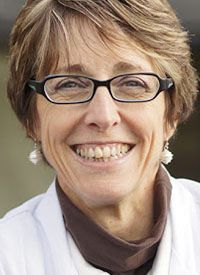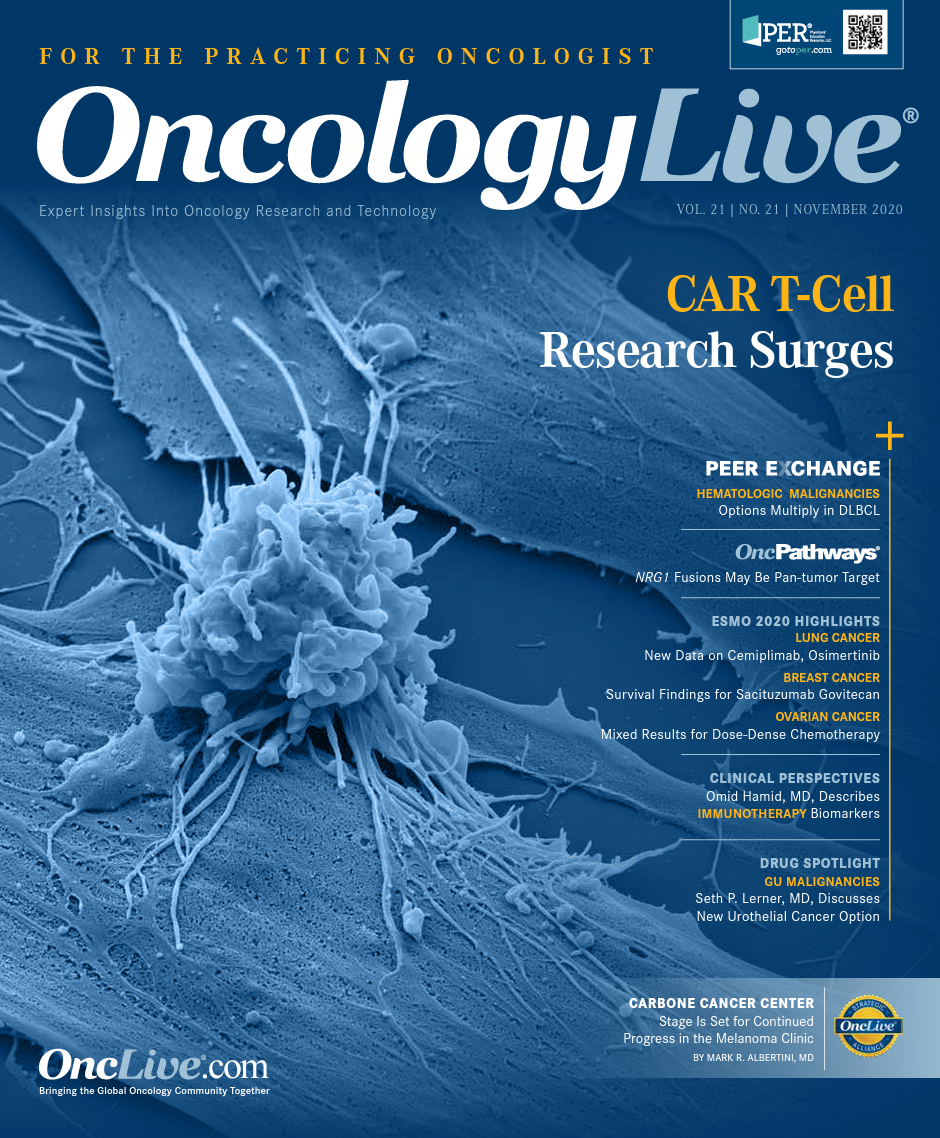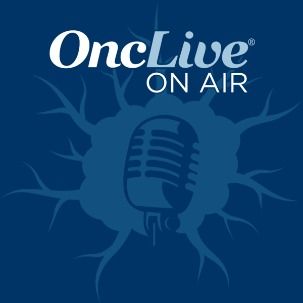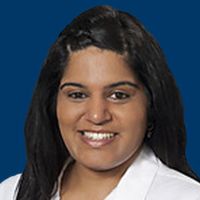Publication
Article
Oncology Live®
French Study Sheds Light on COVID-19 Stress Among Patients With Cancer
Author(s):
Patients on active therapy during the coronavirus disease 2019 pandemic, as well as oncology care providers, have increased levels of perceived and posttraumatic stress, according to preliminary data from the COVIPACT study.
Florence Joly, MD, PhD

Patients on active therapy during the coronavirus disease 2019 (COVID-19) pandemic, as well as oncology care providers, have increased levels of perceived and posttraumatic stress, according to preliminary data from the COVIPACT study. These data highlight a gap in psychosocial support resources that help promote emotional resilience and reduce the risk of posttraumatic stress in patients on active therapy.
Baseline results from the prospective trial (NCT04366154) presented at the European Society for Medical Oncology Virtual Annual Congress 2020 showed that “there was a high level of stress among patients,” according to Florence Joly, MD, PhD, who led the data review.
Between April 8 and May 29, 2020, during the French lockdown, investigators collected questionnaire responses on patients’ psychoemotional status. The COVIPACT population included 621 patients with hematological malignancies or solid tumors receiving systemic therapies from the outpatient departments of 2 respective French cancer centers. Assessing the proportion of patients with treatment modifications during the COVID-19 lockdown in France was the primary end point of the study.
Investigators reported that modifications occurred in 27% of patients, including treatment interruptions for 15%, post-ponement for 32%, changes to the administration schedule for 19%, and adapted monitoring for 30%. Treatment modifications were more frequent in patients receiving single-agent immune checkpoint inhibition (49%) and targeted therapy–based combination therapy (47%; Table). Notably, shifts in administration schedule were more common in patients who initiated treatment during the lockdown (33.0% vs 15.6%).
Table. Treatment Modifications Observed in the COVIPACT Study
Measuring “the psychological impact of the pandemic-related lockdown” on patients and medical oncologists was the secondary end point of COVIPACT. Patients were asked to fill out self-questionnaires on:
- impact of event scale–revised (IES-R),
- perceived stress (PSS),
- sleep difficulty severity/insomnia (ISI),
- quality of life (QOL), and
- cognitive complaint (FACT-COG).
Completed stress-related questionnaires were available for 93% of patients. Medical oncologists were also asked to complete self-questionnaires on PSS, as well as on professional accomplishment and personal efficiency.
Impact of Event Results
Posttraumatic stress questionnaires—corresponding to stress related to the event—contained 22 items and used IES-R which categorized results as high, medium, or low stress. Results from this questionnaire showed that patients with cancer who were subject to COVID19–related oncological treatment modifications experienced higher stress; specifically, of the 152 patients who experienced modification, 27% experienced high stress compared with 19% of the 423 patients whose therapeutic course was not altered (P = .049).
Further, low stress levels per IES-R were also slightly elevated among patients who experienced a treatment modification versus those who did not (35% vs 32%). “We assessed the pandemic-induced therapeutic modifications of patients’ cancer treatment and the psychological impact on patients and caregivers,” said Joly, head of medical oncology at François Baclesse Cancer Centre in Caen, France. Findings from the baseline analysis indicate that treatment modifications have a “negative impact on stress” in patients, she added.
In contrast with the high and low findings in the IES-R questionnaire, medium stress levels were more prevalent among patients who did not have a treatment modification versus those who did (49% vs 38%). Overall, 46% of the 575 questionnaire responders said they experienced medium stress. Low stress related to the event accounted for 33% of the questionnaire responses; high, 21%.
Patient-Reported Stress, Insomnia, QOL
The stress patterns in the IES-R analysis were also present in the PSS evaluation. In the 571 completed PSS questionnaires, 48%, 46%, and 6% of the responses indicated low, medium, and high levels of perceived stress, respectively. Just as treatment modifications led to a greater likelihood that patients would report high event-related stress, they also predisposed patients to experience higher perceived stress. Nine percent of patients whose treatment was changed said they had high perceived stress compared with 5% of patients whose treatment was not altered (P = .061).
Low levels of perceived stress remained slightly elevated among patients with modifications (50% vs 47%), whereas medium levels were more common among patients who did not experience a treatment modification compared with those who did (49% vs 41%, respectively).
A total of 570 patients responded to the insomnia questionnaire. Those who did not have a treatment modification were moderately less likely to have no or slight insomnia (77% vs 75%). The opposite was true for moderate or severe insomnia, which affected 25% of patients with a modification and 23% without one, respectively.
Interestingly, despite their effects on patient-reported stress, COVID-19–related treatment modifications did not negatively affect patients’ QOL from a cognitive standpoint, Joly said. In both patients who did and did not experience treatment alterations, the FACT-COG QOL score was the same, 4.6 (P = .5).
Sense of Accomplishment, Stress Both High Among HCPs
Questionnaires from 73 respondents quantified the psychological impact of the COVID-19 quarantine on medical oncologists and oncology day care unit caregivers. The mostly female caregiver population (81%) comprised 35 nurses, 4 nursing assistants, 23 medical oncologists (including 1 hematologist), 5 residents, and 6 contributors in other qualifying but unspecified roles. The median age was 40 years (range, 22-63).
When evaluated in the caregiver cohort, PSS questionnaire results showed that health care providers (HCPs) were experiencing high levels of perceived stress, Joly said. The continuous PSS score was 16.3 (± 7.1). When stratified by high, medium, and low, the PSS scores were 10%, 53%, and 37%, respectively. Most respondents (56%) felt a low level of emotional exhaustion.
Despite observed stress, HCPs reported high levels of professional accomplishment and personal self-efficacy, noted Joly. Specifically, 60% said they felt a high sense of professional accomplishment. Thirtythree percent felt a medium level of personal accomplishment, and only 7% reported a low perception of accomplishment. Data also showed that the personal self-efficacy score was 32.8 (of 40.0; ± 4.5).
Patients and participating HCPs were asked to respond to the questionnaires at not only baseline but also 3- and 6-month follow-ups. Following the presentation of the baseline findings on patient stress and other cognitive and QOL-related factors, the next step in the COVIPACT study is “evaluating the evolution of psychosocial parameters over these 2 periods after the lockdown among patients and caregivers,” Joly said.
These data are expected to shed light on the longer-term magnitude of treatment modifications on patients with cancer, as well as the determinants of posttraumatic stress for both patients and providers. In the meantime, oncology centers should seek to establish psychosocial support resources for patients receiving active therapy in an effort to minimize IES-R, Joly concluded.
Reference
- Joly F, Leconte A, Grellard JM, et al. LBA69: impact of the COVID-19 pandemic on management of medical cancer treatments and psychological consequence for the patients. Ann Oncol. 2020;31(suppl 4): S1200. doi:10.1016/j.annonc.2020.08.2310





























%20(2)%201-Recovered-Recovered-Recovered-Recovered-Recovered-Recovered-Recovered-Recovered-Recovered-Recovered-Recovered-Recovered-Recovered-Recovered-Recovered-Recovered-Recovered.jpg?fit=crop&auto=format)
%20(2)%201-Recovered-Recovered-Recovered-Recovered-Recovered-Recovered-Recovered-Recovered-Recovered-Recovered-Recovered-Recovered-Recovered-Recovered-Recovered-Recovered-Recovered.jpg?fit=crop&auto=format)
